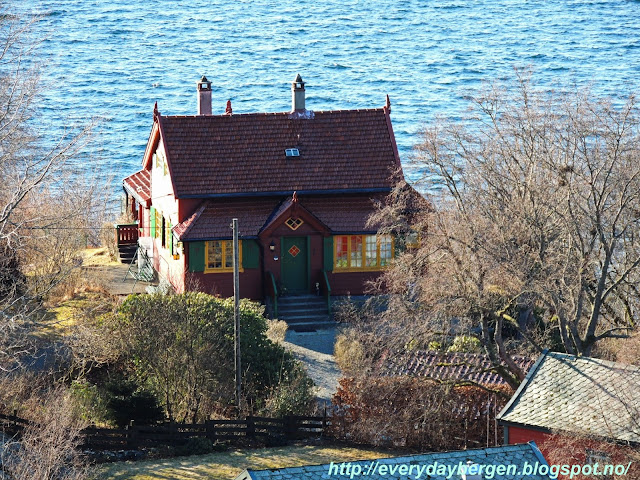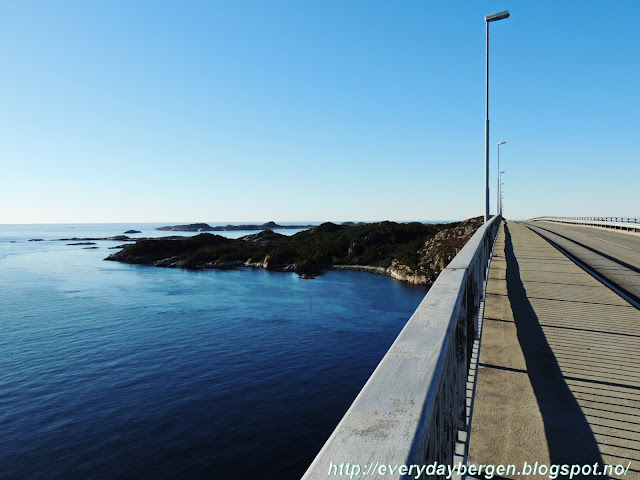Bergen from every side.
My view of MY Heritage city.
Every day.
In BERGEN,
In Hordaland,
In Norway.
31 March 2013
30 March 2013
29 March 2013
Tellevik coastal fort
Tellevik coastal fort is a German coastal fort from World War II, built on Klauvaneset in Åsane , Bergen . The project was started in 1940 and continued until the war's end. Much of the work was carried out by Russian prisoners of war from camps in Saurås and Liarinden . Tellevik coastal fort was part of Festung Bergen .
The fortress is today reckoned as a war memorial , and is partially restored.
Text by Wikipedia.
Etykiety:
Bergen,
Tips for Trips
Lokalizacja: Bergen, Norway
Bergen, Norway
28 March 2013
Nordhordland Bridge
The Nordhordland Bridge (Norwegian: Nordhordlandsbrua) is a combined cable-stayed and pontoon bridge which crosses Salhusfjorden between Klauvaneset and Flatøy in Hordaland, Norway. It is 1,614 meters (5,295 ft) long, of which the pontoon section is 1,246 meters (4,088 ft) long. The cable-stayed section consists of a single 99-meter (325 ft) tall H-pylon which has a length of 368 meters (1,207 ft) and a main span of 172 meters (564 ft). This allows for a clearance of 32 meters (105 ft).
The floating section is a steel box girder bridge with ten pontoons, which because of the fjord's depth are not laterally anchored. The roadway sits on an orthotropic deck. The pontoons and the cable-stayed bridge are built in concrete, with the main span being supported with 48 cables. The fjord end of the main span is supported by a 30-meter (98 ft) deep foundation, where the two bridges meet. From there and for 414 meters (1,358 ft), the roadwall has a 5.7 percent gradient on a viaduct anchored to the pontoon bridge.
The bridge carries two lanes of European Route E39, also called the Coastal Highway, and one pedestrian and bicycle path, and connects the district of Nordhordland to Bergen. Plans for a bridge had existed since the 1960s, and after the decision to construct the bridge was passed by the Parliament of Norway in 1989, construction started in 1991. Total costs, including auxiliary roads, was NOK 910 million. Part of the contract payment was subject to a court case which the contractors lost. The bridge opened on 22 September 1994, and remained a toll road until 31 December 2005. In 2009, it had an average daily traffic of 14,698 vehicles. There are plans to reinstate a toll on the bridge from 2013 to finance other road projects. The bridge is the second-longest in Norway, and the second pontoon bridge in Norway.
Text by Wikipedia
Here is the full version with all technical aspects.
http://en.wikipedia.org/wiki/Nordhordland_Bridge
Etykiety:
Bergen,
Tips for Trips
Lokalizacja: Bergen, Norway
Bergen, Norway
27 March 2013
Walk on Nygård part 2
Nygård is the part of Bergen center. It is completly different like the Sandviken. It is a part of stone buildings, including Grieghallen and some parts of Bergen University.
Etykiety:
Bergen,
Tips for Trips
Lokalizacja: Bergen, Norway
Bergen, Norway
26 March 2013
Walk on Nygård part 1
Etykiety:
Bergen,
Tips for Trips
Lokalizacja: Bergen, Norway
Bergen, Norway
25 March 2013
Johanneskirken
St. John's Church (Norwegian: Johanneskirken) is a cruciform church in Bergen, Norway.
St. John's Church is located on Sydneshaugen in the neighbourhood of Sydnes in Bergen. St John's was built between 1891 and 1894 in the Gothic Revival style. With 1250 seats, it is the largest church in Bergen.
In 1888, an architectural contest was conducted for the design of a new church. It was built from drawings by architect, Herman Major Backer (1856–1932). The frescoes in the Church's ceiling date from 1924 and were completed by Hugo Lous Mohr (1889-1970). The building process was first lead by architect Adolf Fischer and from 1891 by Hans Heinrich Jess. The church was consecrated in 1894.
The organ was built by Schlag and Sohn of Wurttemberg. It was modernized by JH Jørgensen of Oslo during 1967. The altarpiece depicts Christ in prayer and was designed in 1894 by Marcus Grønvold. The church tower is the highest in the city at 61 metres. The main tower has four stair towers and a carillon. It was designed by Verein Bochum in Bochum, Westphalia.
Text by Wikipedia
Etykiety:
Bergen,
Tips for Trips
Lokalizacja: Bergen, Norway
Bergen, Norway
24 March 2013
23 March 2013
Statsraad Lehmkuhl - The Beauty
The Statsraad Lehmkuhl is a three-masted barque rigged sail training vessel owned and operated by the Statsraad Lehmkuhl Foundation. It is based in Bergen, Norway and contracted out for various purposes, including serving as a school ship for the Royal Norwegian Navy (using RNoN's prefix "KNM", English: "HNoMS").
It was built in 1914 as a school training ship for the German merchant marine under the name Grossherzog Friedrich August. After the First World War the ship was taken as a prize by the United Kingdom and in 1921 the ship was bought by former cabinet minister Kristoffer Lehmkuhl (hence the name, which means "Cabinet Minister Lehmkuhl"). With the exception of the Second World War, when she was captured by German troops and called Westwärts, the ship has belonged to Bergens Skoleskib until it was donated to the Foundation in 1978.
In 2000, it was chartered by the German Navy while their Gorch Fock was overhauled.
Tekst by Wikipedia
Lokalizacja: Bergen, Norway
Bergen, Norway
22 March 2013
21 March 2013
Rongesundet (The Bridge)
Spring time, spring light. Nature call. Here is some view from and on the Rongesundet Brigde, located in Sotra.
20 March 2013
Henrik Ibsen 185 anniversary
Henrik Johan Ibsen (20 March 1828 – 23 May 1906) was a major 19th-century Norwegian playwright, theatre director, and poet. He is often referred to as "the father of realism" and is one of the founders of Modernism in the theatre. His major works include Brand, Peer Gynt, An Enemy of the People, Emperor and Galilean, A Doll's House, Hedda Gabler, Ghosts, The Wild Duck, Rosmersholm, and The Master Builder. He is the most frequently performed dramatist in the world after Shakespeare, and Pravda has reported that A Doll's House is the world's most performed play.
Several of his plays were considered scandalous to many of his era, when European theatre was required to model strict morals of family life and propriety. Ibsen's work examined the realities that lay behind many façades, revealing much that was disquieting to many contemporaries. It utilized a critical eye and free inquiry into the conditions of life and issues of morality. The poetic and cinematic play Peer Gynt, however, has strong surreal elements.
Ibsen is often ranked as one of the truly great playwrights in the European tradition. Richard Hornby describes him as "a profound poetic dramatist—the best since Shakespeare". He is widely regarded as the most important playwright since Shakespeare. He influenced other playwrights and novelists such as George Bernard Shaw, Oscar Wilde, Arthur Miller, James Joyce, and Eugene O'Neill.
Text by Wikipedia
For 185 anniversary. This is Henrik Ibsen postument in Bergen.
Etykiety:
Bergen
Lokalizacja: Bergen, Norway
Bergen, Norway
DNS - Den Nationale Scene
Den Nationale Scene is the largest theatre in Bergen, Norway. Den Nationale Scene is also one of the oldest permanent theatre in Norway.
Founded under the name Det Norske Theatre in 1850, the theatre has roots dating back to its founding on the initiative of the Norwegian violinist Ole Bull. The theatre was founded to develop Norwegian playwrights. Henrik Ibsen was one of the first writers-in-residences and art-directors of the theatre and it saw the première in Norway of his first contemporary realist drama The Pillars of Society (Samfundets støtter) on 30 November 1877.
In 1909, The National Theatre moved into the new theater building at Engen. The current theater building was designed by Einar Oscar Schou, and opened 19 February 1909 with a production of Erasmus Montanus by Ludvig Holberg. King Haakon VII of Norway and Queen Maud were in attendance. It soon became apparent that the building was too small. In 1913 the company bought Ekserserhuset Jonsvoll to use it as a warehouse. In 1920, an extension was built to the northwest. Over the years the building has undergone major changes, extensions, renovation, restoration and stage technical modernization. The foyer and the hall were destroyed during the Second World War, and only temporarily restored.
The Theatre experienced a pre-war high point during the period 1934-39 under the leadership Hans Jacob Nilsen. Especially noteworthy was the 1935 premiere of the play Vår ære og vår makt ("Our Honor and our Power") by Nordahl Grieg.
In 2001 the building was brought almost to its original shape. Today the theatre houses three stages/ venues and presents approximately 20 productions each year, both international and national classics, musicals and contemporary drama, as well as children's theatre. Since 1993, the theatre has been state property.
Etykiety:
Bergen,
Norway,
Tips for Trips
Lokalizacja: Bergen, Norway
Bergen, Norway
Subscribe to:
Posts (Atom)




.JPG)
.JPG)
.JPG)
.JPG)
.JPG)
.JPG)
.JPG)
.JPG)
.JPG)
.JPG)
.JPG)
.JPG)
.JPG)
.JPG)
.JPG)










.JPG)



.JPG)








.JPG)






